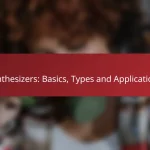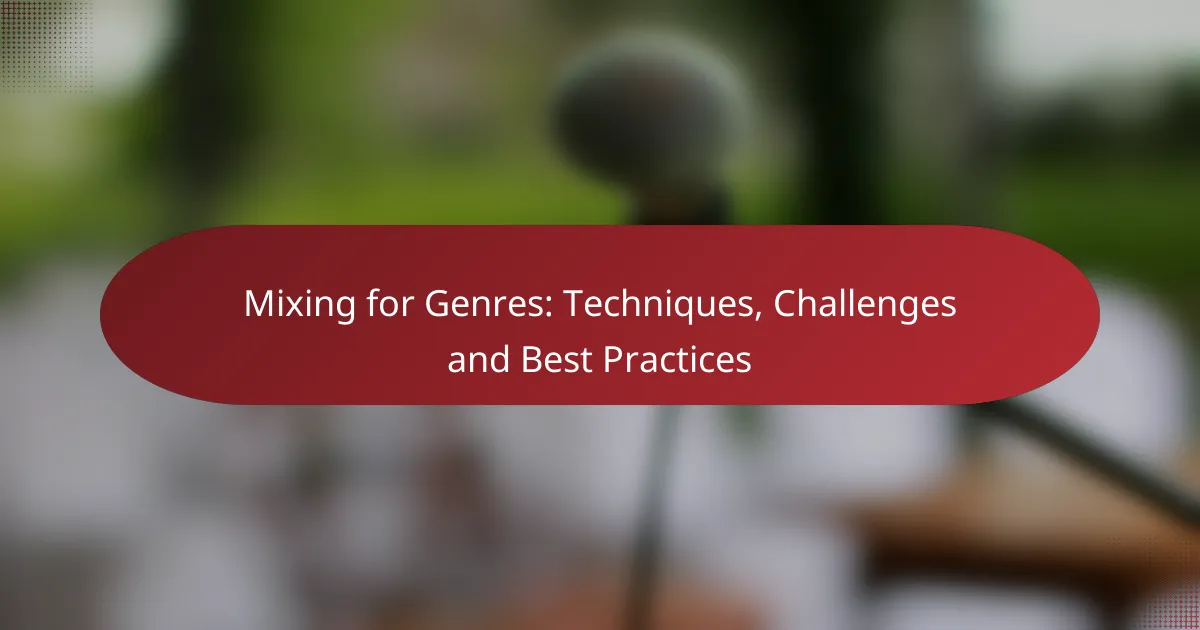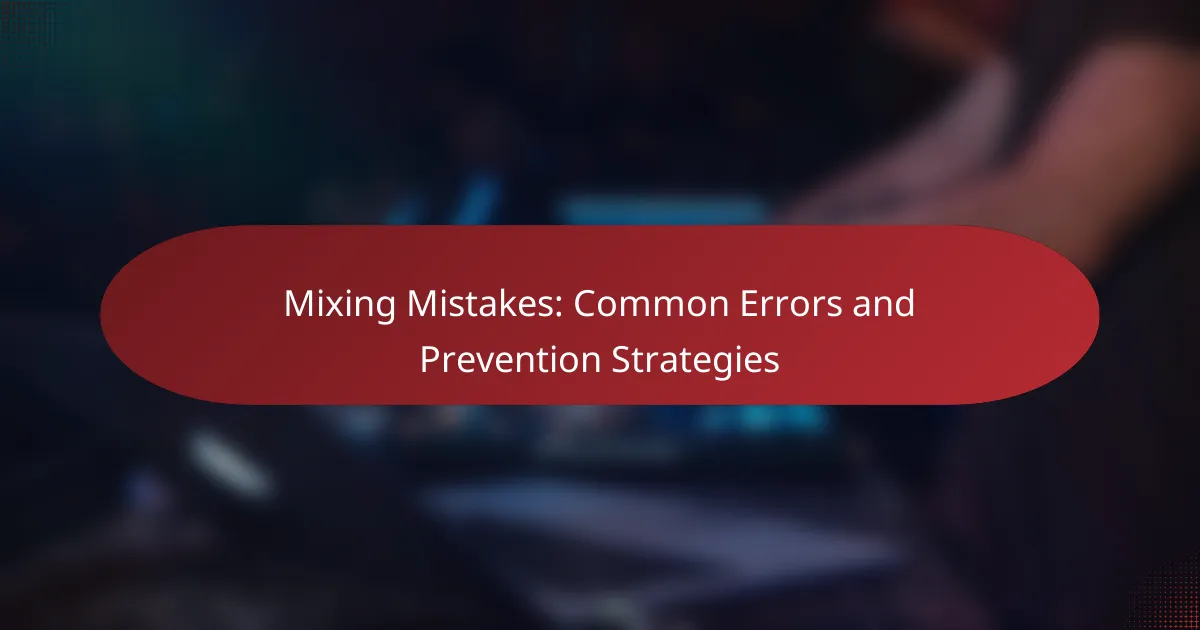Effective EQ strategies are crucial for new producers aiming to enhance the clarity and emotional impact of their mixes. By mastering frequency ranges and utilizing the right tools, such as DAWs and equalizer plugins, producers can create balanced and resonant soundscapes. Continuous practice and education in EQ techniques will significantly improve mixing skills and overall production quality.

What are effective EQ strategies for mixing music?
Effective EQ strategies for mixing music involve techniques that enhance clarity, balance, and emotional impact. By understanding frequency ranges and applying EQ thoughtfully, producers can create mixes that resonate with listeners.
Active listening techniques
Active listening is crucial for identifying how different elements in a mix interact. Focus on specific frequency ranges while listening to your track and note any areas that feel cluttered or unbalanced. Use reference tracks to compare tonal qualities and ensure your mix translates well across various playback systems.
Consider using tools like spectrum analyzers to visualize frequency distribution. This can help you pinpoint problematic areas that may need adjustment, allowing for a more informed approach to EQ decisions.
Emotional balance in sound selection
Selecting sounds that evoke the desired emotional response is essential in mixing. Choose instruments and samples that complement each other and contribute to the overall mood of the track. For example, warm pads can create a comforting atmosphere, while sharp synths may evoke tension.
Be mindful of how different sounds interact in the mix. Strive for emotional balance by ensuring that no single element overwhelms others, which can detract from the intended feeling of the music.
Dynamic range management
Dynamic range management is vital for maintaining clarity and impact in your mix. Use EQ to carve out space for each element, allowing them to coexist without masking one another. For instance, reducing low frequencies in vocals can help them sit better with bass instruments.
Aim for a dynamic range that feels natural yet engaging. Avoid excessive compression that can squash the mix, as this may lead to listener fatigue. Instead, focus on achieving a balance that enhances the emotional delivery of the music.
Layering sounds for emotional impact
Layering sounds effectively can significantly enhance emotional depth in a mix. Combine different instruments or samples that occupy similar frequency ranges but have distinct tonal qualities. This technique can create a richer, more immersive listening experience.
When layering, be cautious of phase issues that may arise. Use EQ to adjust the frequencies of each layer, ensuring they complement rather than conflict with one another. This will help maintain clarity while maximizing emotional resonance.
Using EQ to enhance emotional response
EQ can be a powerful tool for enhancing emotional response in music. By boosting or cutting specific frequencies, you can emphasize certain characteristics of a sound that evoke feelings. For example, boosting mid-range frequencies can bring warmth and intimacy to vocals.
Experiment with subtle adjustments to see how they affect the overall mood of the track. Remember that less is often more; small changes can lead to significant emotional shifts without overwhelming the listener.
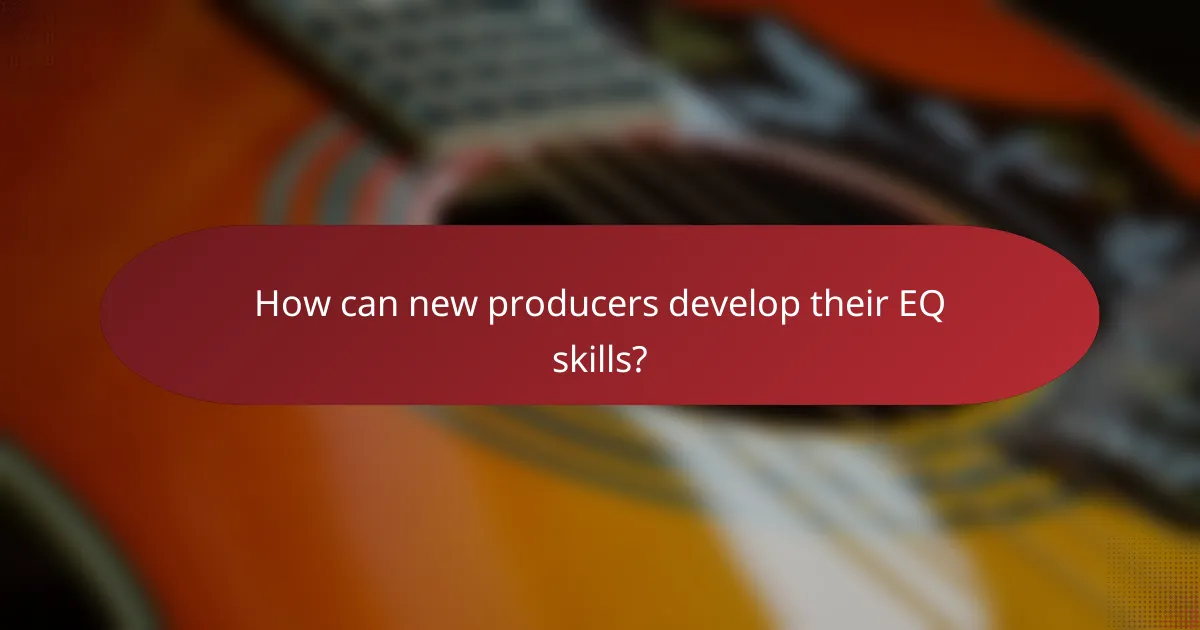
How can new producers develop their EQ skills?
New producers can develop their EQ skills by actively practicing and applying techniques that enhance their mixing abilities. This involves understanding frequency ranges, using tools effectively, and seeking educational resources to refine their skills.
Practice with reference tracks
Using reference tracks is an effective way for new producers to develop their EQ skills. By comparing their mixes to professionally produced songs, they can identify frequency imbalances and tonal qualities that they may want to replicate. Aim to choose tracks in a similar genre to ensure relevant comparisons.
To practice, listen to a reference track and analyze its frequency distribution. Use an EQ analyzer to visualize the frequency spectrum, then apply similar adjustments to your own mix. This method helps in understanding how different elements sit within the mix and how EQ can enhance clarity.
Utilize EQ plugins like FabFilter Pro-Q 3
Utilizing high-quality EQ plugins, such as FabFilter Pro-Q 3, can significantly improve a producer’s mixing capabilities. This plugin offers a user-friendly interface and precise control over frequency adjustments, making it easier to learn and apply EQ techniques effectively.
Experiment with features like dynamic EQ and mid/side processing to enhance your mixes. For instance, you can cut unwanted frequencies in the mid channel while boosting them in the side channel, creating a more spacious sound. Familiarize yourself with the plugin’s capabilities to maximize its potential in your workflow.
Attend workshops or online courses
Attending workshops or online courses can provide valuable insights into EQ techniques and mixing strategies. Many platforms offer courses specifically tailored to beginners, focusing on practical applications and real-world examples that can enhance learning.
Look for courses that include hands-on projects and feedback from instructors. Engaging with a community of fellow producers can also provide support and inspiration. Consider platforms like Skillshare or Coursera, which often feature courses on audio production and mixing fundamentals.
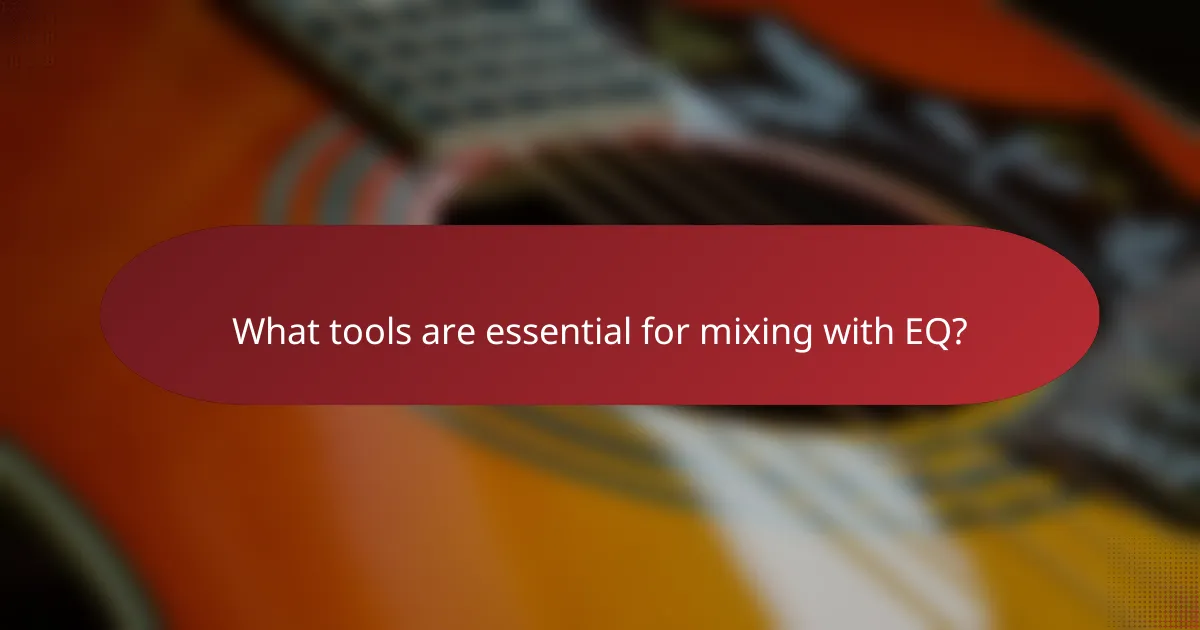
What tools are essential for mixing with EQ?
Essential tools for mixing with EQ include Digital Audio Workstations (DAWs), equalizer plugins or hardware, and analyzers for visual feedback. These tools help producers shape sound, balance frequencies, and ensure clarity in mixes.
Digital Audio Workstations (DAWs)
A DAW is the central hub for music production, allowing you to record, edit, and mix audio. Popular options like Ableton Live, Logic Pro, and Pro Tools offer built-in EQ tools that are crucial for effective mixing. When choosing a DAW, consider its user interface, compatibility with plugins, and the specific features that suit your workflow.
Many DAWs provide visual representations of audio tracks, making it easier to identify frequency issues. Familiarizing yourself with your DAW’s EQ capabilities can significantly enhance your mixing skills.
Equalizer plugins and hardware
Equalizer plugins and hardware are vital for adjusting the tonal balance of your audio tracks. Software options like FabFilter Pro-Q and Waves SSL E-Channel are popular for their versatility and precision. Hardware EQs, while often more expensive, can add a unique character to your sound.
When using EQ, focus on cutting frequencies that clash rather than boosting others excessively. A common practice is to make subtle adjustments, typically in the range of 1-3 dB, to maintain a natural sound.
Analyzers for visual feedback
Analyzers provide visual feedback on the frequency spectrum of your audio, helping you identify problem areas. Tools like iZotope Ozone and Voxengo Span can show you where frequencies are concentrated and where adjustments are needed. This visual aid is particularly useful for beginners who may struggle to hear certain frequency imbalances.
When using analyzers, aim for a balanced spectrum without excessive peaks in specific ranges. Regularly reference your mix against professional tracks to ensure your EQ decisions are on the right track.

What are common mistakes in EQ mixing?
Common mistakes in EQ mixing include over-EQing tracks, neglecting the context of the mix, and ignoring frequency masking issues. These errors can lead to a cluttered sound and an unbalanced mix, making it difficult for individual elements to shine.
Over-EQing tracks
Over-EQing tracks involves applying excessive equalization, which can strip away the natural character of sounds. Producers often boost frequencies too much or cut them too aggressively, resulting in a harsh or unnatural tone.
A good rule of thumb is to make subtle adjustments, typically no more than 3 dB at a time. Always compare the processed sound with the original to ensure you’re enhancing rather than detracting from the track’s quality.
Neglecting the context of the mix
Neglecting the context of the mix means failing to consider how each track interacts with others. Each element should complement the overall sound rather than compete for attention.
To avoid this mistake, listen to the mix as a whole rather than in isolation. Adjust EQ settings based on how each track fits within the entire arrangement, ensuring that key elements like vocals or lead instruments are clearly audible.
Ignoring frequency masking issues
Ignoring frequency masking issues occurs when certain frequencies overlap, causing sounds to become indistinct. This is particularly common with bass and kick drum interactions, where low frequencies can obscure one another.
To address masking, identify overlapping frequencies and use EQ to carve out space for each element. For instance, you might cut some low-end from guitars to allow the bass to stand out more clearly. Regularly checking your mix in mono can also help reveal masking problems.
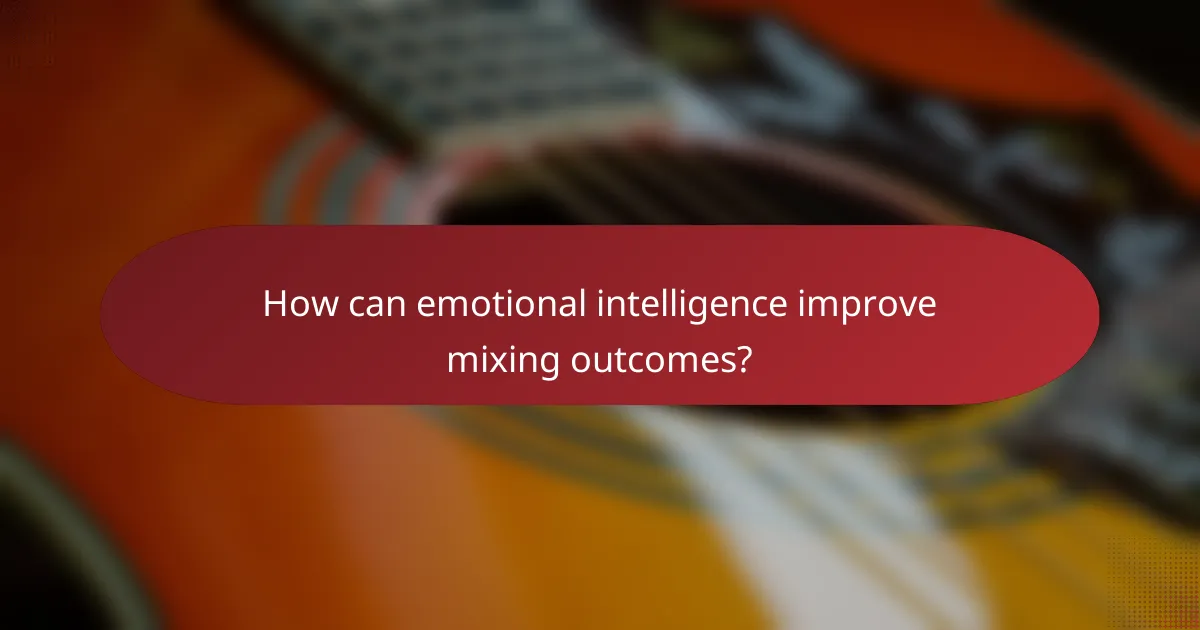
How can emotional intelligence improve mixing outcomes?
Emotional intelligence can significantly enhance mixing outcomes by allowing producers to connect with their audience on a deeper level. By understanding emotions and the psychological impact of sound, producers can create mixes that resonate more effectively with listeners.
Understanding listener psychology
Understanding listener psychology involves recognizing how different sounds, frequencies, and dynamics evoke emotions. For instance, higher frequencies can create feelings of excitement, while lower frequencies often evoke calmness or tension. Producers should consider these psychological effects when selecting sounds and arranging elements in a mix.
To effectively engage listeners, producers can use techniques like contrast and dynamics. For example, alternating between loud and soft sections can maintain interest and evoke emotional responses. Additionally, being aware of cultural differences in sound perception can help tailor mixes to specific audiences.
Creating a narrative through sound
Creating a narrative through sound means structuring a mix to tell a story or convey a specific emotion. This can be achieved by thoughtfully arranging elements, such as introducing themes and motifs that evolve throughout the track. A well-crafted narrative can guide listeners through an emotional journey, making the experience more memorable.
Producers can enhance their mixes by using techniques like call-and-response or layering sounds that complement each other. For instance, starting with a simple melody and gradually adding harmonies can build tension and anticipation. It’s essential to maintain coherence in the narrative to ensure that listeners remain engaged from start to finish.
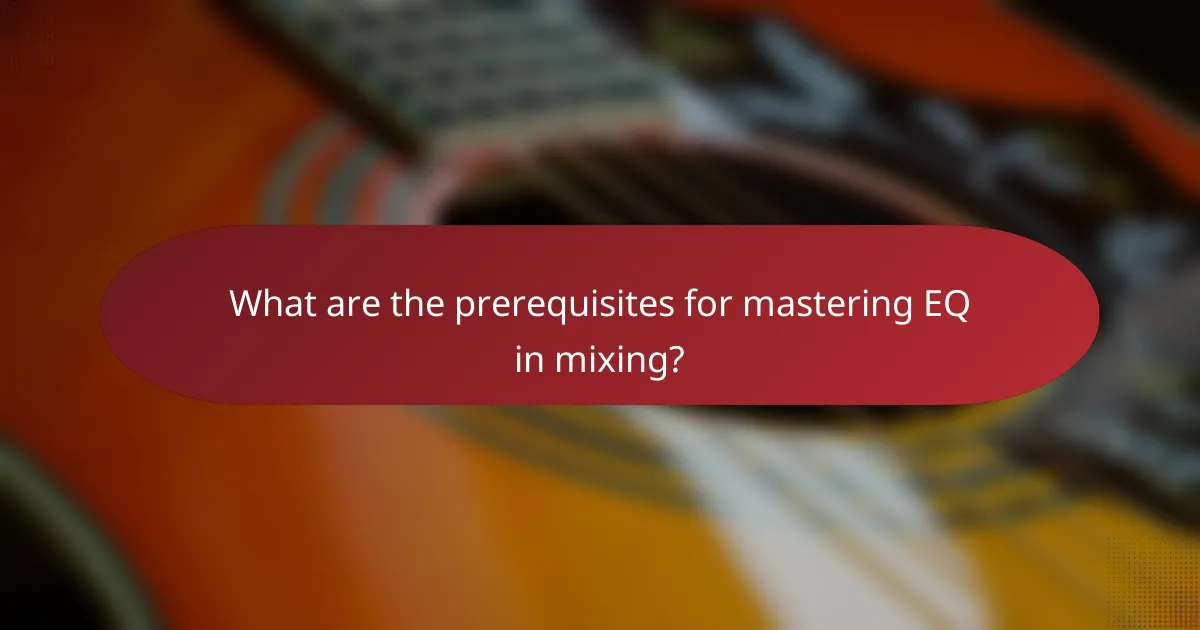
What are the prerequisites for mastering EQ in mixing?
To master EQ in mixing, producers need a solid understanding of sound frequencies and how they interact. Familiarity with audio equipment and software, as well as basic mixing techniques, is essential for effective equalization.
Understanding Frequency Ranges
Each instrument and vocal has a specific frequency range that contributes to its unique sound. Understanding these ranges helps in making informed EQ decisions. For example, bass instruments typically occupy the low frequencies (20-250 Hz), while vocals often sit in the mid-range (250 Hz-4 kHz).
Producers should familiarize themselves with the frequency spectrum to identify where to boost or cut frequencies. This knowledge allows for clearer mixes and helps avoid frequency clashes between instruments.
Listening Skills
Developing critical listening skills is crucial for EQ mastery. Producers should practice identifying different frequencies and their effects on sound. Regularly comparing mixed tracks with reference tracks can sharpen these skills.
Using headphones and studio monitors can help in discerning subtle differences in EQ adjustments. Listening in various environments also aids in understanding how mixes translate across different playback systems.
Basic Mixing Techniques
Before diving into EQ, producers should grasp fundamental mixing techniques such as panning, volume balancing, and dynamics processing. These elements work together with EQ to create a cohesive mix.
Applying EQ effectively often requires an understanding of how it interacts with compression and reverb. For instance, cutting certain frequencies before applying compression can lead to a cleaner sound.




